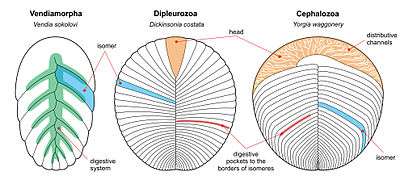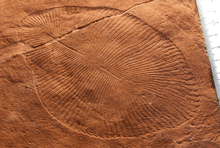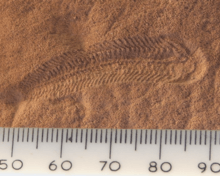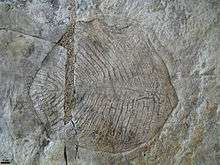Proarticulata
Proarticulata is a proposed phylum of extinct, bilaterally symmetrical animals known from fossils found in the Ediacaran (Vendian) marine deposits, and dates to approximately 567 to 550 million years ago.[1][2] The name comes from the Greek προ (pro-) = "before" and Articulata, i.e. prior to animals with true segmentation such as annelids and arthropods. This phylum was established by Mikhail A. Fedonkin in 1985 for such animals as Dickinsonia, Vendia, Cephalonega, Praecambridium[3] and currently many other Proarticulata are described (see list).[4][5]
| Proarticulata | |
|---|---|
 | |
| Several proarticulates | |
| Scientific classification | |
| Kingdom: | Animalia |
| Clade: | Bilateria |
| Phylum: | †Proarticulata Fedonkin, 1985 |
| Class / Family | |
| |
Due to their simplistic morphology, their affinities and mode of life are subject to debate. They are almost universially considered to be metazoans, and due to possessing a clear central axis have been suggested to be stem-bilaterians. In the traditional interpretation, the Proarticulartan body is divided into transverse articulation (division) into isomers as distinct from the transverse articulation segments in annelids and arthropods, as their individual isomers occupy only half the width of their bodies, and are organized in an alternating pattern along the longitudinal axis of their bodies.[5] In other words, one side is not the direct mirror image of its opposite (chirality). Opposite isomers of left and right side are located with displacement of half of their width. This phenomenon is described as the symmetry of gliding reflection.[6][7] Some recent research suggests that some proarticulatans like Dickinsonia have genuine segments, and the isomerism is superficial and due to taphonomic distortion.[8] However, other researchers dispute this.[9][10] Displacement of left-right axis is known in bilaterians, notably lancelets.[11][12]
Morphology

Vendiamorpha
The body is completely segmented, with all isomers curved towards the posterior, and the first isomer is normally much larger than the rest. The first two isomers at the anterior dorsal end are partly fused. (e.g., Vendia, Paravendia and Karakhtia).[6][13][14][15]
Cephalozoa
These proarticulatans are incompletely segmented, as the anterior zone is free of isomers, often making a "hairband" like appearance. (example cephalozoans include Yorgia, Praecambridium, Andiva, Archaeaspinus, Ivovicia, Spriggina, Marywadea and Cyanorus.)[6][13][15][16] Some cephalozoans from the family Yorgiidae demonstrate pronounced asymmetry of left and right parts of the body. For instance, Yorgia’s initial right isomer is the only one which spreads far towards the left side of the body. Archaeaspinus has an unpaired anterior lobe confined by the furrow to the left side only.[6][7][15]
Dipleurozoa
The dipleurozoan body is subradial, divided by isomers entirely (e.g., Dickinsonia and Phyllozoon). Dickinsonia juveniles show undivided anterior areas but these regions were reduced in the course of ontogeny, and in the adult stages Dickinsonia-like proarticulates changed so radically that they became almost indistinguishable from isomers.[13][16][17]
Proarticulata Incertae sedis
In Cephalonega stepanovi and Tamga hamulifera all isomers are encircled by a peripheral undivided zone.[16] In the former, the isomers remain in contact with each other, forming a raft-like region, while in the latter, the isomers are isolated from each other and do not touch. In Lossinia, the center undivided region has no visible isomers, instead having the lobe-like isomers emanate from the periphery of the undivided region as "transverse articulations."[16]
List of Proarticulata





Body fossils
- Armillifera Fedonkin, 1980[18]
- A. parva Fedonkin, 1980
- A. ivantsovi Fedonkin, 2002
- A. fedonkini Ivantsov, 2001
- Cephalonega Ivantsov et al., 2019[20]
- Chondroplon Wade, 1971 (possible =Dickinsonia)
- C. bilobatum Wade, 1971
- C. singularis Ivantsov, 2004
- Dickinsonia Sprigg, 1947
- D. costata Sprigg, 1947
- D. lissa Wade, 1972
- D. menneri Keller 1976[16] (=Vendomia menneri Keller 1976[21])
- D. tenuis Glaessner et Wade, 1966
- Ivovicia Ivantsov, 2007[16]
- I. rugulosa Ivantsov, 2007
- Karakhtia Ivantsov, 2004
- K. nessovi Ivantsov, 2004
- L. lissetskii Ivantsov, 2007
- Marywadea Glaessner, 1976
- M. ovata Glaessner et Wade, 1966
- Ovatoscutum Glaessner et Wade, 1966
- O. concentricum Glaessner et Wade, 1966
- P. janae Ivantsov, 2001 (=Vendia janae Ivantsov, 2001)
- Phyllozoon Jenkins et Gehling, 1978
- P. hanseni Jenkins et Gehling, 1978
- Podolimirus Fedonkin, 1983
- P. mirus Fedonkin, 1983
- Praecambridium Glaessner et Wade, 1966
- P. siggilum Glaessner et Wade, 1966
- Spriggina Glaessner, 1958
- S. floundersi Glaessner, 1958
- T. hamulifera Ivantsov, 2007
- Valdainia Fedonkin, 1983
- V. plumosa Fedonkin, 1983
- V. sokolovi Keller, 1969
- V. rachiata Ivantsov, 2004
- ? Windermeria Narbonne, 1994
- W. aitkeni Narbonne, 1994[22]
- Y. waggoneri Ivantsov, 1999
See also
References
- Maslov AV, Podkovyrov VN, Grazhdankin DV, Kolesnikov AV (2018). "Upper Vendian in the east, northeast and north of East European Platform: Depositional processes and biotic evolution". Litosfera. 18 (4): 520–542. doi:10.24930/1681-9004-2018-18-4-520-542.
- Kolesnikov AV, Liu AG, Danelian T, Grazhdankin DV (2018). "A reassessment of the problematic Ediacaran genus Orbisiana Sokolov 1976". Precambrian Research. 316: 197–205. Bibcode:2018PreR..316..197K. doi:10.1016/j.precamres.2018.08.011.
- Fedonkin MA (1985). "Systematic Description of Vendian Metazoa". In Sokolov BS, Iwanowski AB (eds.). Vendian System: Historical–Geological and Paleontological Foundation. 1: Paleontology. Moscow: Nauka. pp. 70–106.
- Fedonkin MA (31 March 2003). "The origin of the Metazoa in the light of the Proterozoic fossil record" (PDF). Paleontological Research. 7 (1): 9–41. doi:10.2517/prpsj.7.9.
- Ivantsov AY, Fedonkin MA, Nagovitsyn AL, Zakrevskaya ZA (2019). "Cephalonega, a new generic name, and the system of Vendian Proarticulata". Paleontological Journal. 53 (5): 447–454. doi:10.1134/S0031030119050046.
- Ivantsov AY (2001). "Vendia and Other Precambrian "Arthropods"". Paleontological Journal. 35 (4): 335–343.
- Ivantsov AY (1999). "A New Dickinsoniid from the Upper Vendian of the White Sea Winter Coast (Russia, Arkhangelsk Region)". Paleontological Journal. 33 (3): 233–241.
- Dunn FS, Liu AG, Donoghue PC (May 2018). "Ediacaran developmental biology". Biological Reviews of the Cambridge Philosophical Society. 93 (2): 914–932. doi:10.1111/brv.12379. PMC 5947158. PMID 29105292.
- Ivantsov AY, Zakrevskaya MA, Nagovitsyn AL (June 2019). "Morphology of integuments of the Precambrian animals, Proarticulata". Invertebrate Zoology. 16 (1): 19–26. doi:10.15298/invertzool.16.1.03.
- Ivantsov Y, Fedonkin MA, Nagovitsyn AL, Zakrevskaya MA (September 2019). "Cephalonega, A New Generic Name, and the System of Vendian Proarticulata". Paleontological Journal. 53 (5): 447–454. doi:10.1134/s0031030119050046.
- Blum M, Feistel K, Thumberger T, Schweickert A (April 2014). "The evolution and conservation of left-right patterning mechanisms". Development. 141 (8): 1603–13. doi:10.1242/dev.100560. PMID 24715452.
- Soukup V (2017). "Left-right asymmetry specification in amphioxus: review and prospects". The International Journal of Developmental Biology. 61 (10–11–12): 611–620. doi:10.1387/ijdb.170251vs. PMID 29319110.
- Ivantsov AY (2004). "New Proarticulata from the Vendian of the Arkhangel'sk Region" (PDF). Paleontological Journal. 38 (3): 247–253. Archived from the original (PDF) on 2007-09-27.
- Ivantsov AY, Malakhovskaya YE, Serezhnikova EA (2004). "Some Problematic Fossils from the Vendian of the Southeastern White Sea Region" (PDF). Paleontological Journal. 38 (1): 1–9. Archived from the original (PDF) on 2007-07-04.
- Ivantsov AY (2004). "Vendian Animals in the Phylum Proarticulata" (PDF). The Rise and Fall of the Vendian Biota. IGSP Project 493. Prato, Italy. p. 52.
- Ivantsov AY (April 2007). "Small Vendian transversely Articulated fossils". Paleontological Journal. 41 (2): 113–122. doi:10.1134/S0031030107020013.
- Ivantsov AY, Malakhovskaya YE (2002). "Giant Traces of Vendian Animals" (PDF). Doklady Earth Sciences. 385 (6): 618–622. Archived from the original (PDF) on 2007-07-04.
- Ivantsov AY (December 2010). "Paleontological evidence for the supposed precambrian occurrence of mollusks". Paleontological Journal. 40 (12): 1552–1559. doi:10.1134/S0031030110120105.
- Fedonkin MA (2002). "Andiva ivantsovi gen. et sp. n. and related carapace‐bearing Ediacaran fossils from the Vendian of the Winter Coast, White Sea, Russia". Italian Journal of Zoology. 69 (2): 175–181. doi:10.1080/11250000209356456.
- Ivantsov AY, Fedonkin MA, Nagovitsyn AL, Zakrevskaya MA (2019). "Cephalonega, a new generic name, and the system of Vendian Proarticulata". Paleontological Journal. 53 (5): 447–454. doi:10.1134/S0031030119050046.
- Keller BM, Fedonkin MA (1976). "New Records of Fossils in the Valdaian Group of the Precambrian on the Syuz'ma River" (PDF). Izv. Akad. Nauk SSSR, Ser. Geol. (in Russian). 3: 38–44. Archived from the original (PDF) on 2007-09-27.
- Narbonne GM (May 1994). "New Ediacaran fossils from the Mackenzie Mountains, Northwestern Canada". Journal of Paleontology. 63 (3): 411–416. doi:10.1017/S0022336000025816. JSTOR 1306192.
- Ivantsov AY (May 2011). "Feeding traces of Proarticulata — the Vendian metazoa". Paleontological Journal. 45 (3): 237–248. doi:10.1134/S0031030111030063.
External links
- Database of Ediacaran Biota Advent of Complex Life